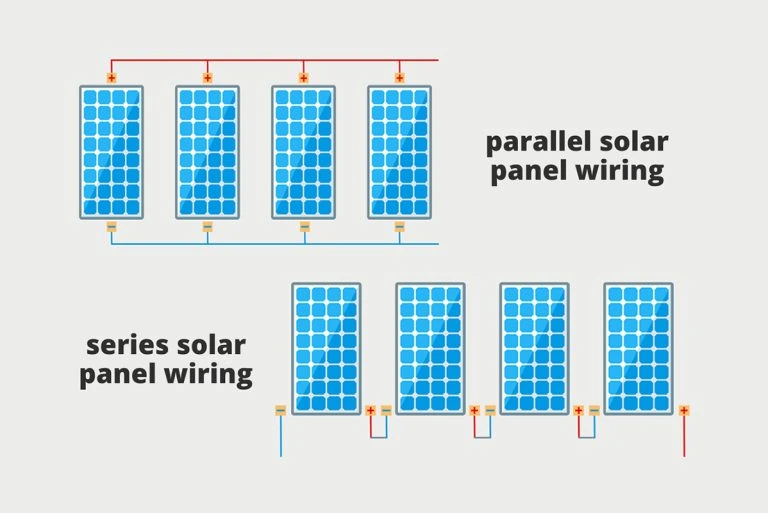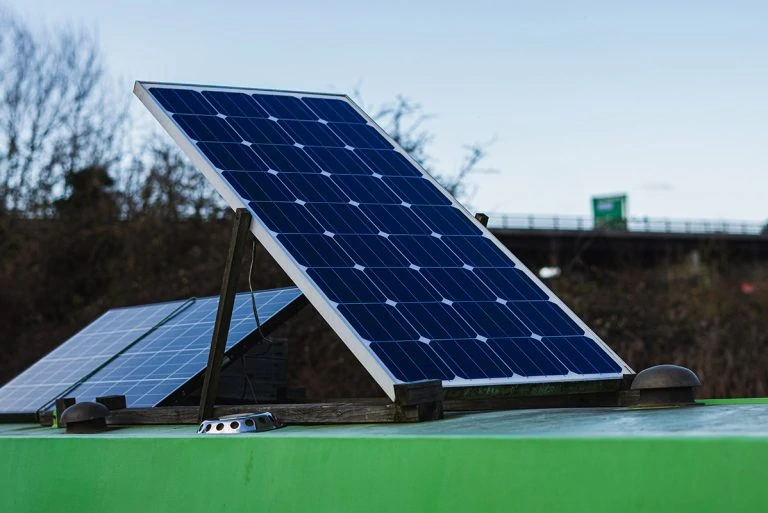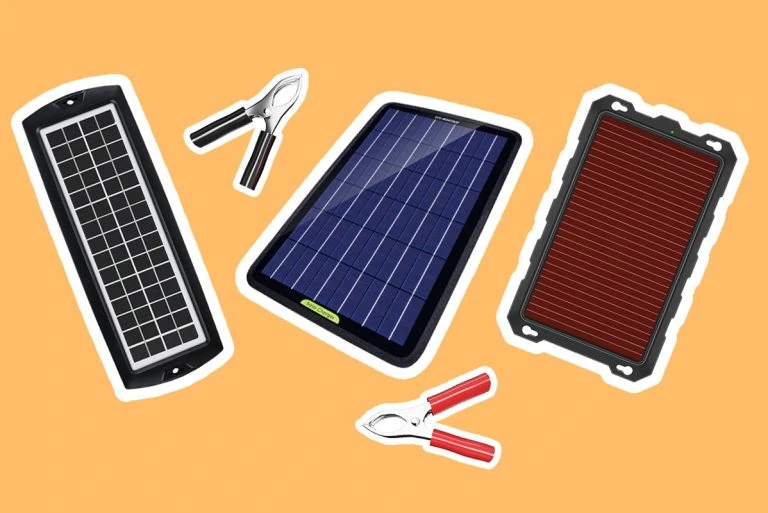Would you like to tap into the sun’s abundant energy for your cabin, camper, RV, or boat, but worry about selecting the best equipment for your project? Maybe you’re a survivalist or relief worker who needs a quick energy supply, but don’t have time to research your options.
One easy solution, whether you’re starting your journey into the solar world or prepping to make it through rough conditions, is a solar kit.
Top 5 off-grid solar panel kits on the market
Let’s take a look at the best off-grid solar panel kits to help you easily setup your own solar system.
1. Best all-around off-grid large solar kit: Renogy Solar Starter Kit
Renogy 400W monocrystalline solar panels (4 pcs.) with 40A MPPT charge controller.
Specifications and features:
- Item weight: 16.5 lbs.
- Panel dimensions: 42.2 x 19.6 x 1.38 in.
- Input voltage: 12V
- Rover charge controller peak efficiency: 98%
- Rover charge controller peak tracking efficiency: 99%
- Bluetooth module
- IP65-rated junction box
- Pre-drilled holes on panel backs
- Waterproof 10A inline fuse
- 40A ANL fuse
- Z-brackets (4)
- 10AWG solar adaptor kit (20 ft.)
- 8AWG tray cable (8 ft.)
- 8AWG fuse cable (2 ft.)
For people who’d like to support a renewable energy company founded in the United States, Renogy is the established go-to. Most Renogy customers are extremely pleased with their solar products.
Advantages:
This kit comes with monocrystalline panels rated at 21%, one of the highest ratings on the market today. The panels are longer and thinner than other kit panels.
The charge controller is built with a 4-stage battery charging process that increases charging efficiency and protects the battery life.
It comes with an IP65-rated junction box and water-proof fuses, making this kit suitable for marine applications.
The included bluetooth module can be paired to the DC Home app, allowing you to monitor and change your system’s settings easily from your smartphone.
Renogy offers a 25-year power output warranty with this breakdown: 5 year/95% efficiency rate, 10 year/90% efficiency rate, 25-year/80% efficiency rate.
Their material and workmanship warranty is for 5 years.
Disadvantages:
It is worth mentioning that few people have claimed Renogy customer service was not responsive and that instructions were not in the box. Reviewers on Renogy’s site made the same comment, so this is definitely something to be aware of, particularly if the possibility of having to figure things out on your own is a dealbreaker.
However, at the time of this writing, there were over 250 questions on the Amazon page for this kit, many of which were answered by Renogy reps, so it does seem that the company is making an effort to be more supportive.
A majority of reviewers had no problems assembling this kit.
2. Budget-friendly large off-grid solar kit: Acopower Solar RV Kits
Acopower 400W and 12/24V Polycrystalline Panels (4 pcs.) with 40A MPPT Charge Controller.
Specifications and features:
- Product weight: 20.94 lbs.
- Input voltage: 12V or 24V
- Panel dimensions: 40.25 x 26.5 x 1.38 in.
- Pre-drilled holes on panel backs
- Midas Y series charge controller peak conversion efficiency 98%
- Charge controller tracking efficiency 99.5%
- Compatible with lead acid, AGM, gel, and lithium batteries
- 12 AWG PV cable (30 ft.)
- 8 AWG tray cable (8 ft.)
- T/Y connectors (3 pr.)
- Z brackets (4)
- Waterproof cable entry housing
Advantages:
The major advantage of this kit is the 40A MPPT controller. It also protects your batteries better through temperature compensation than a PWM controller, thereby extending battery life.
By comparison, PWM controllers have only a 70% efficiency. They will charge your batteries, but unless you’re on a very tight budget, always choose a MPPT controller.
All mounting hardware and cables are included in this kit. Depending on whether you wire them in parallel or in series, this kit could charge a 12V or a 24V battery bank.
Disadvantages:
There is no panel efficiency rating on the Amazon page for this kit. A search on the Acopower website states that it is 14.5%. This is average for polycrystalline panels. The panels are shorter and wider than other panels.
The PV modules carry a 5-year workmanship warranty and a 25-year 85% transferable power output warranty. The controller and all other kit components are under warranty for one year.
3. Easily expandable small off-grid solar kit: Rich Solar Starter Kit
Rich Solar offers a 200W kit ( 2 pcs.), perfect for those with fewer electrical power needs who may wish to build up later.
Specifications and features:
- Product weight: 15 lbs.
- Input voltage: 12V or 24V
- Panel dimensions: 45.5 x 20.5 x 1.25 in.
- Rich Solar charge controller peak conversion efficiency 97%
- 10AWG PV cable (20 ft.)
- 10AWG tray cable (10 ft.)
- Parallel connectors (1 pr.)
- Z brackets (4)
- 15A inline fuse holder with fuse
Advantages:
At 200W, the panels will charge a 12V battery easily. This may be all you’re looking for so you can keep your solar array simple.
However, because of the powerful 40A MPPT charge controller, you can easily expand your system and add on more PV modules for a total wattage of 800W.
The monocrystalline panels in the Rich Solar kit are rated at 18.4% efficiency, which is on the low end for monocrystalline panels but still quite good.
A bluetooth module is included in this kit for remote monitoring of your system.
Disadvantages:
On the Amazon question page, Rich Solar stated that y connectors (to connect the panels) are not included. But they pointed out that they’d send them for free if asked after purchasing.
Rich Solar also responded to a question by saying that the controller does not have a temperature sensor.
On the Rich Solar website, the only warranty information listed for this kit was for 25-year output performance.
4. Budget-friendly small off-grid solar starter kit; water-proof: SereneLife Solar Starter Kit
SereneLife sells a monocrystalline panel starter kit with two panels, each rated at 100W and a 30A PWM charge controller.
Specifications and features:
- Product weight: 42.3 lbs.
- Input voltage: 12V or 24V
- Panel dimensions: 35.4 x 26.4 x 1.25 in.
- Charge controller peak conversion efficiency not given
- Compatible with lead-acid and lithium ion batteries
- 11AWG cable set (3 ft.) connected to panels
- 11AWG cable (20 ft.)
- 10AWG PV cable (8 ft.)
- Parallel connectors (1 pr.)
- Mounting brackets (2 sets)
- Wire fixers (10)
- 15A fuse
Serene Life is a company that features many different products for home and garden. On its website, all of its photovoltaic kits are “unavailable,” although they are for sale on Amazon.
Advantages:
All Amazon reviewers raved about this product, so it merited a place in this list.
Several reviewers attached photos of what they had received out of the box and their final setups. One reviewer included his own video of how this system is working so far. He noticed that the controller has two USB ports so you’d be able to charge small devices with no problem.
Another reviewer mentioned that the instruction manual is very user-friendly, including detailed information on the charge controller settings.
For boaters: This kit comes with an IP67 rating which means it’s waterproof so suitable for marine applications.
Disadvantages:
This system comes with a less efficient 30A PWM charge controller. However, it may meet all of your needs.
There is no warranty information or PV panel efficiency rating on the Serene Life website. Given that this company is not exclusively dealing with renewable energy products, you may not receive technical help if you have questions.
5. Budget-friendly large off-grid solar kit: Windy Nation Solar Kit
WindyNation 400W polycrystalline solar panels (4 pcs.) with 30A PWM charge controller.
Specifications and features:
- Product weight: 17.6 lbs.
- Input voltage: 12V or 24V
- Panel dimensions: 40 x 26.4 x 1.2 in.
- P30L WindyNation charge controller: peak conversion efficiency not given
- 12AWG cable (40 ft.)
- Connectors (1 pr.)
- Branch connectors (3 pr.)
- Z mounting brackets (16)
- Fasteners (16 sets)
Windy Nation is an established clean energy company specializing in both wind and solar DIY power. The company website is full of testimonials (with photos) from DIYers. The website is also home to an active forum for customers on all things solar and wind energy related.
Advantages:
Even though the controller is only rated at 30A, all four 100W panels could be connected to it without risk of damaging it or an attached battery. However, to add more than four 100W panels, you must upgrade the controller to a device that can support at least 40A.
In other words, the cheaper and lower-rated PWM controller is adequate in this system making it a budget-friendly option.
The charge controller comes equipped with a temperature sensor for battery protection.
Windy Nation offers three warranties:
- 25-year power output
- 5-year solar panel
- 1-year on all other kit components
As of this writing, there are close to 100 questions on the Amazon page for this product, many of which are answered by Windy Nation. So, customer support is not lacking.
Disadvantage:
For newbies looking to snap pre-attached connectors together, this kit is not for you. Users must cut the cable to length and attach connectors.
Although the website provides links to all the manuals for each part of the installation process, the efficiency ratings of the panels and the charge controller were not listed. Nor was it located after searching on multiple website pages. Without knowing these values, it’s difficult to determine if this really is a good deal or not.
What is a solar panel kit?
A solar panel kit is an easy-to-assemble set of materials sold as an individual package. After assembly, you’ll have a functional solar power system, usually off-grid.
While every solar kit is unique, there are some commonalities. At the bare minimum, you’ll find:
- Photovoltaic (PV) panels
- Charge controller (Not needed for solar trickle chargers)
- Mounting hardware
- Wiring
- Fuses
Optional materials in a solar kit include:
- Battery
- PV disconnects
- Inverter
- Power optimizers
Not included in most solar kits, but likely needed in installation are:
- Mechanical tools (wrenches, screwdrivers, etc.)
- Electric drill and bits (if holes aren’t already precut in the frames or placed where you’d like them to be)
- Wire crimping and cutting tools
While it’s true there is some sophisticated componentry in a solar system, purchasing a solar kit removes a lot of the technical mystery about necessary equipment. If a kit includes a detailed instruction manual, you’ll also know the correct way to set up the system.
Hopefully, the solar kit manufacturer will be available to help with any questions on a dedicated customer service line or on their website.
A big advantage of using a solar kit is that you don’t need to be a certified electrician to get powered by the sun. However, if your system is connected to the utility power grid, you will need a professional to sign off on it in addition to getting proper permitting.
Why buy a solar panel kit?
For newbies to the solar world, a good quality solar kit provides peace of mind that your setup is complete and efficient. Everything you need comes in one box. There’s no need to purchase individual pieces and wonder if they’re compatible.
A solar kit may save you money, too. To check, you can price individual components to see if they’d be cheaper when purchased as a kit or separately.
However, if you’re a DIYer who likes a challenge, designing your own solar system from scratch may be the way to go.
And there’s always the option of professional installation for those who want to do their part for the planet but don’t wish to get too hands-on in the process.
How to choose the right solar panel kit
Before you purchase a solar panel kit, there are several aspects to consider.
Off-grid versus grid-tied solar kits
If you’re planning on powering a cabin in a remote area or looking for energy independence when you’re RVing or camping, a solar kit built for off-grid use is ideal. Depending on your energy requirements, battery storage may be required.
On the other hand, if you’d prefer the convenience of the power grid to fall back on (assuming no outages) in case your system can’t meet your energy needs, a grid-tied solar kit is your best bet.

Whether you decide on the off-grid or grid-tied option, you may wish to integrate a battery backup to your solar array, but this is optional. It all depends on how much backup power you want to store in batteries after taking into account your daily energy consumption.
Portable versus stationary solar kits
There are some solar projects that involve electrifying a permanent building like a tool shed or barn. For these, solar kits should include mounts, racks, and possibly poles plus bolts and brackets needed to install a solar array either on the ground or on a roof.
If you’re looking to travel with your solar setup, portable PV panels are the name of the game. These modules may be smaller than those for rooftop or ground mount solar. Flexible solar panels are another option.
Calculating your energy needs
Before you buy a solar kit that fits your needs, figure out what the electrical power needs are that you want the PV panels to supply.
To do so:
- List all the appliances you wish to operate from your solar array.
- Look on the appliance labels for information about their electrical requirements.
- Determine the energy they consume during the time you’ll be using them in one day.
- Add all the values from your list to arrive at your total daily energy need.
To do Step 3, multiply the power of each appliance (given in watts) by the number of hours you’ll be using it in a day. The result is expressed in watt hours (Wh) or kilowatt hours (kWh).
The power rating of an appliance tells you how much energy it consumes. The higher the wattage on a label means the more energy it draws when operating.
In cases where the wattage isn’t listed on an appliance but the voltage and current are, use this equation to calculate the power:
Power (W) = voltage (V) x current (A)
- Voltage is like the pressure or amount of force that electricity has when it’s moving in a wire or any conducting material. When you’re trying to determine if a solar panel will power a certain appliance, look at the voltage. For example, an appliance that runs on 12V will do so when hooked up to a 12V solar panel.
- Current refers to how much electricity is moving at a given moment and is measured in amps. Current determines how thick the wires in your system need to be to carry the electricity safely. For example, an appliance with an amp rating of 40 may need an 8 gauge wire going to a battery bank or a breaker box. A fuse rated slightly above 40A and placed between the appliance and the power source will protect the appliance and prevent too much current going to it. Otherwise, a fire could result.
On a practical level, your panels’ amperage determines the thickness of the wires you need to connect your system. Thicker wires cost a lot more than thinner ones!
This factor is especially relevant if your PV array is located far from what it is you wish to electrify (like a ground mount array on a sunny hill and a far-off cabin in a shady spot).
There are many online calculators available that step you through the process of determining the number of watt hours you want to supply. With this information, you can figure out the most economical PV setup — in terms of the panels’ voltage and amp ratings — to look for in a solar kit.
Incidentally, this information is useful when choosing the correct battery bank for your solar setup. Using the central relationship — Power (W) = voltage (V) x current (A) — you can determine the power that any battery can store.
For instance, if a battery is rated “100 amp hour 12 volt,” multiplying those two ratings gives you the watt hours it can store (100 Ah x 12 V = 1,200 Wh = 1.2 kWh). To get the best price on batteries, compare their watt hour ratings.
Figuring out how many solar panels you need
The next step in buying a solar kit is determining the number of PV modules that will meet all of your energy needs.
For example, a 200W panel in a solar kit can output 40 volts at 5 amps or 50 volts at 4 amps when operating optimally. (Recall from above: Power (W) = voltage (V) x current (A). So 200 W = 40 V x 5 amps or 50 V x 4 amps, for example.)
However, the sun isn’t shining all the time. Nor is it shining at equal intensity over the course of “daylight” hours or over the course of a year.
There are many other factors – like dust, air pollution haze, angle of panels – that will reduce the solar panels’ power output. So, realistically speaking, a 200W panel may produce only 175W some or most of the time.
Likewise, a PV module could yield more than its rated power, possibly 5-10% more. This is likely on cool, sunny days when the panels are more efficient at capturing and transmitting solar energy.
In general, a PV panel outputs only 70% of what it’s rated for. So, if you have 400W total for your array, the actual power is only 400W x 0.7 = 280W.
To partially account for some of these differences when you’re figuring out how many panels you need, calculate the actual sunlight power available to your panels over time (usually 4-5 hours per day). Only then will you be able to compare your real energy demands to actual energy generation from your PV panels.
There are maps available of sunlight hours and seasonal and latitude changes. These will help you increase the accuracy of your calculations.

Image source: NREL
As an example, say you have a panel rated at 200W. The actual number of watts it can output under ideal conditions varies slightly. It may be 210W.
When the panel receives 4 hours of full sun per day, then the total daily energy produced from that panel is 210W x 4 hrs. = 840 Wh.
If that panel is connected in series with three other identical 200W modules, the total energy generated in a day is 4 x 840 Wh = 3,360 Wh = 3.36 kWh.
Finally, compare that value of electrical energy produced from your solar kit array with the value you calculated earlier of your energy demand.
If your system doesn’t generate enough to meet your needs, purchase a larger solar kit instead. If it’s too powerful, scale back or invest in battery storage for the excess energy.
To give you some idea of how many kilowatt hours common appliances that you may wish to operate off-grid in a cabin or RV use per hour:
- Portable heater: 1.5 kWh
- Floor fan: 0.03 kWh
- Water heater: 12.7 – 16.7 kWh
- Microwave: 1.44 kWh
- Coffee maker: 0.4 kWh
- Toaster oven: 0.75 kWh
- Laptop: 0.05 kWh
- Radio: 0.02 kWh
So, as the example above showed, if your solar array of four 200W panels produces only 3.36 kWh in one day, you could not operate too many appliances too long unless you had significant battery backup.
In all cases when you’re calculating the amount of electrical energy produced by your solar array, be aware that solar panels degrade slightly over time, losing their ability to generate electricity.
To offset this anticipated loss, you may wish to add panels to your array in 5-10 years or more to maintain the same energy production you get at the beginning.
If you’re thinking along these lines, before purchasing a solar kit, make sure that its components are compatible with additional panels. Or, you may need to make costly upgrades to the system later.
How to evaluate solar kits
For newcomers to solar energy, solar kit product reviews is a good place to start your journey.
Product reviews are often loaded with technical jargon and numerical data. Here you’ll find out what to look for and how to compare products so that you’ll make a wise decision on the best solar kit to meet your needs.
When comparing solar kits, here are the key criteria to consider:
- Performance
- Warranty
- Price
Solar kit performance
How well do the solar cells generate power? In other words, what is the efficiency of the panels?
When analyzing electrical specification (i.e., spec) sheets, you should find two sets of data:
- NOCT (nominal operating cell temperature) performance data measured in real-world conditions (usually at 45℃)
- STC (standard test conditions) data taken at 25℃ and 1 kW/㎡ luminosity
NOCT data reveal more useful information for you as a consumer.
Purchasing Tip: To determine which panel is the best-performing one, make sure you’re looking at NOCT data sets for all products.
However, the spec sheets don’t always tell the whole story.
Contrary to popular belief, monocrystalline panels do not necessarily perform better than polycrystalline panels. The video below shows a real world case:
Another useful metric when judging performance is the temperature coefficient. This number tells you how much energy production falls with each degree of temperature rise above 25℃.
For example, a panel with a temperature coefficient of -0.5% on a very hot day at 40℃ will suffer a loss of 0.5 x 15 = 7.5% efficiency. (40-25 = 15.)
If your panel’s starting efficiency is only 18%, your system underperforms at 18 – 7.5 = 10.5%.
Purchasing Tip: A panel with a small temperature coefficient will perform better than one with a large temperature coefficient. This is especially important if you’ll be using your solar array in a very hot climate or season.
Solar kit warranty
Solar kits may or may not come with more than one warranty. Higher quality kits will have more than one warranty. They will be longer, too. There are separate warranties for:
- PV panels
- PV panel performance
- Materials/Workmanship for other kit components
Purchasing Tip: Avoid kits in which the panels are guaranteed for less than 1 year. In terms of performance, aim for 25+ years with 95% efficiency after 5 years, 90% efficiency after 10 years, and 80% efficiency after 20 years.
A materials/workmanship warranty for 10+ years is ideal. Unfortunately, you may find only 1- or 5-year warranties on solar kits.
Longer warranties indicate that the kit components are more durable and of higher quality.
Solar kit price
To compare prices of solar kits, look at the price per Watt. Although using the stated watt values, (for example, 400W), will not reflect reality in terms of performance as discussed in the previous section, they serve as a rough estimate of the equipment’s ability to provide solar power.
Purchasing Tips: Don’t assume that the higher-priced solar kit is better, or that the inexpensive one is not as good.
To be extremely precise when comparing, first price the other high-dollar kit component – the charge controller – separately. Then subtract that value from the listed price to arrive at a more exact price per watt for each kit.
Top 5 off-grid solar kits
Here are your best choices for a solar kit intended for off-grid uses including:
- Small cabin
- RV
- Camper
- Van
- Trailer
- Boat
- Tool shed
- Fence
- Gate
- Greenhouse
Top solar kit table of information
Here’s a quick summary of the key points to consider about our top 5 picks of off-grid solar kits arranged side by side:
| Company | Watts | Number of Panels | Type of Panels | Charge Controller | Price per Watt* |
|---|---|---|---|---|---|
| Renogy | 400W | 4 | Mono | 40A MTTP | $2.00 |
| Acopower | 400W | 4 | Poly | 40A MTTP | $1.45 |
| Rich Solar | 200W | 2 | Mono | 40A MTTP | $1.99 |
| Serene Life | 200W | 2 | Mono | 30A PWM | $1.30 |
| Windy Nation | 400W | 4 | Poly | 30A PWM | $1.35 |
Takeaways on best off-grid solar kits
Off-grid solar kits make it easy to get all the electrical power you need for the sun to supply a cabin, camper, RV, or boat. Determining which one is the best to meet your needs involves comparing them on several levels.
Performance, warranty, and price are major factors to think about before buying. Evidence of customer support and testimonials is also important.
Based on extensive analysis, the top 5 off-grid solar kits are:
- Renogy 400W Monocrystalline 40A MPPT
- Acopower 400W Polycrystalline 40A MPPT
- Rich Solar 200W Monocrystalline 40A MPPT
- SereneLife 200W Monocrystalline 30A PWM
- WindyNation 400W Polycrystalline 30A PWM
Depending on your energy demands, connecting a battery pack for storage may be warranted. In most cases, it will be necessary. Then you’ll be set for decades of renewable energy from your off-grid solar kit.


















